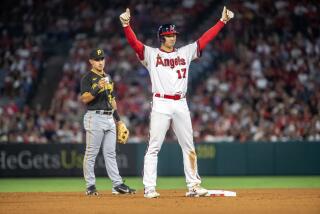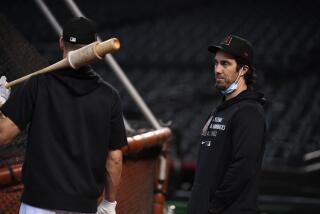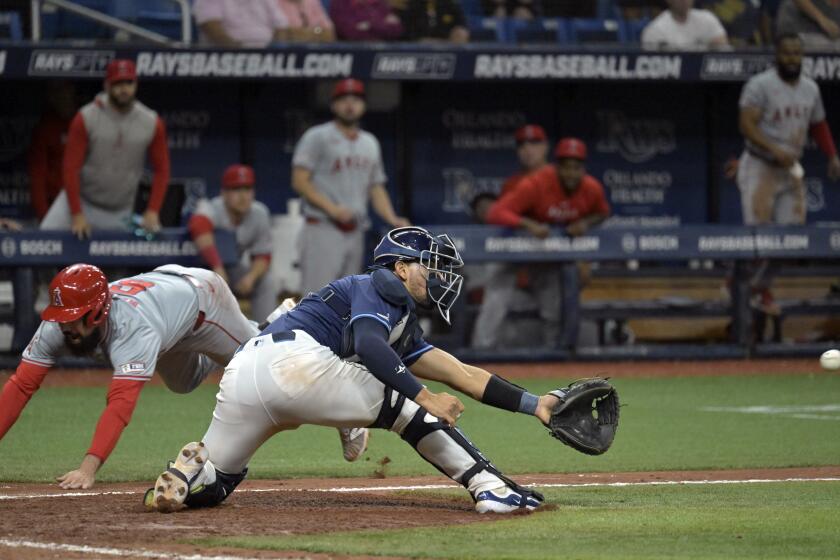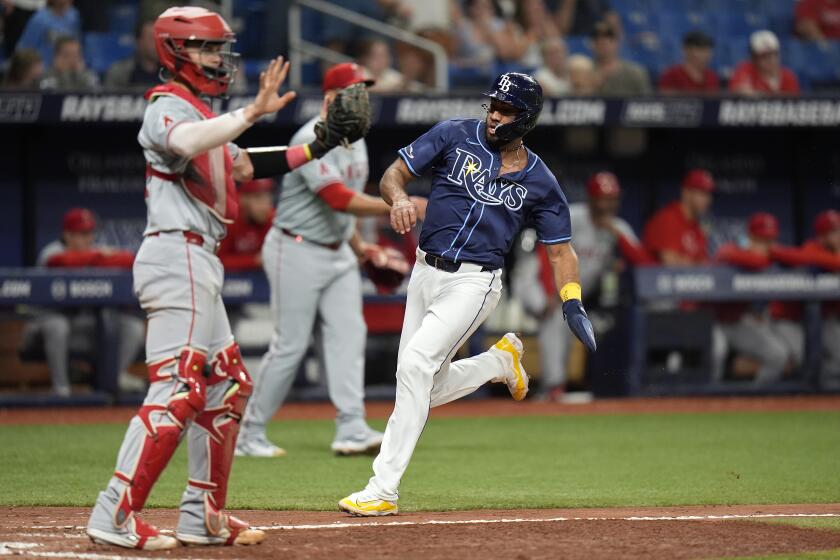Angels’ Bud Norris is carving a niche as a reliever
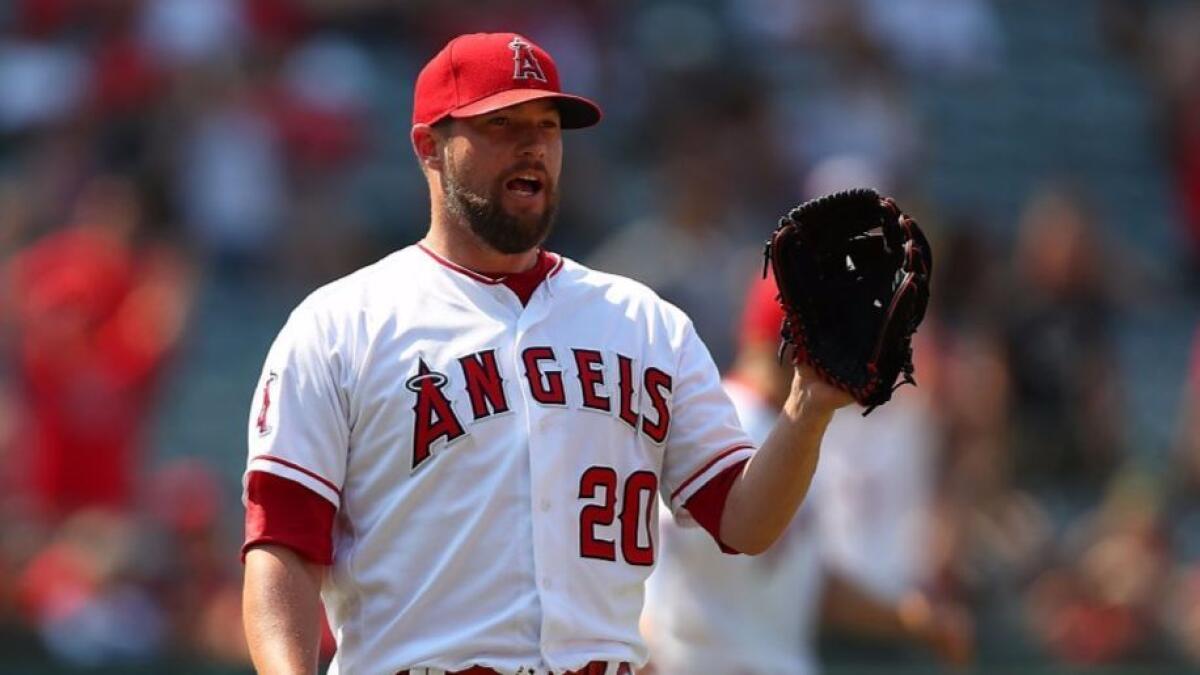
The Baltimore Orioles spent the first week of May 2015 in New York to play the Mets and the Yankees. Between his two scheduled starts there, Bud Norris fell ill. He says he lost 25 pounds in a week, his body flushed. He tried to pitch at Yankee Stadium but couldn’t.
“Something happened, whether it was self-inflicted, internal or whatever,” he said. “My body shut down. It was bad. It was not pretty. And Baltimore didn’t know how to diagnose it.”
He went on the disabled list with what the Orioles called bronchitis. His parents flew to visit and make potfuls of soup. He rushed back, didn’t pitch to his 2014 career-best standard, and was cut.
“I’ve been climbing out of that hole ever since,” Norris said.
From Baltimore, Norris went to San Diego, Atlanta and Los Angeles. The Dodgers acquired him when Clayton Kershaw injured his back in June 2016, then released him one week before the postseason, one start before he could collect a $500,000 bonus. He went home and watched the playoffs, noting the times he thought the Dodgers could have used him.
“It was a rough go, to be honest,” he said.
He was unemployed until the last week of January, when the right-hander signed a minor league contract with the Angels. General manager Billy Eppler told him he’d have a chance to start, pending the progress of others. If not, Norris heard, he could make the team as a reliever.
He did, initially as a long man making multiple-inning appearances. Then injuries forced him to the back of the bullpen. Norris has 15 saves in 16 tries, a 2.23 earned-run average and 51 strikeouts in 40 1/3 innings. Increased use of his cutter has rendered him hard to hit even for left-handed batters.
After a 5.79 ERA in 196 innings over 2015 and 2016, Norris, at 32, has become one of the majors’ better relievers and a key reason the Angels remain in the playoff race.
His success has also made him the club’s most desirable rental. With the trade deadline days away, contending teams have expressed interest in adding him to their bullpens. Only 2 1/2 games out of a playoff spot despite a 49-51 record, the Angels have to decide whether to sell.
Norris is aware. Between 2012 and 2013, he spent months on trade watch with his first team, Houston. He learned he needs support to help process the possibilities.
“I know that it’s a possibility I do get moved,” he said. “It’s a flip of the coin, at times. I don’t necessarily want to get traded right now. I would love to stay here and help this team get to a world championship, because I think we still have an opportunity to do that.
“But I can’t sweep those feelings under the rug. I have to go to my resources: my family, my agent, my sports psychologist. When I can talk about those things and everybody else knows what’s going on, the better I can cope with it.”
::
The last time Norris was available to pitch and Angels manager Mike Scioscia opted for someone else in a save situation was April 18. That night in Houston, Cam Bedrosian suffered a groin strain and Norris ascended one spot in the bullpen hierarchy.
Since then, he has received every chance to close a game while he was on the active roster and not in need of a rest day. His teammates regularly refer to him as the club’s closer and the backbone of a bullpen that has surpassed expectations.
Yet, Scioscia has refused to call Norris the team’s closer. The manager bristled at a recent question about that resistance, then asked for a definition of the term closer.
He was told a closer is commonly thought of as a reliever who pitches in save situations in at least 90% of his appearances.

“Then he’s in that bucket,” Scioscia said. “And some other guys will be in that bucket, too.”
The conversation regressed from there, until Scioscia specifically defined Norris’ role:
“Bud will close games for us. He’s a back-end guy for us. But there are going to be some times when maybe he does pitch the eighth inning and someone else pitches the ninth inning, depending on matchups. I still think we have an element of matchup in our ‘pen that’s worked.”
So far that matchup has resulted in Norris pitching in every save situation.
::
When he reported to spring training, Norris said he still viewed himself as a starting pitcher. Now, he has warmed to the idea of remaining a reliever.
“I think this is what I want to do,” he said last week.
His ultimate goal is to complete 10 years of major league time, which would secure a sizable pension. With continued service, that should happen sometime in August 2019.
“He wants to get those 10 years, to be successful, to find a way to adapt to the bullpen role,” said Blake Parker, another 32-year-old reliever. “Early on, he made the transition very easy. He just knew it was a different type of pitching. He’s finding a way to stick around.”
The millions of dollars Norris already has received in his career prompted him to invest in nutrition and conditioning. In recent years, he has done more cardio work and upper-body strength exercises.
“I always had thick, burly, thunder-thigh legs,” Norris said. “But I never had a core.”
As a result, he is throwing as hard — in the mid-90s — as he was at 24. Just in shorter stints.
Twitter: @pedromoura
More to Read
Go beyond the scoreboard
Get the latest on L.A.'s teams in the daily Sports Report newsletter.
You may occasionally receive promotional content from the Los Angeles Times.

